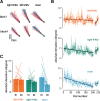Ventrolateral Prefrontal Cortex Contributes to Human Motor Learning
- PMID: 36114001
- PMCID: PMC9532016
- DOI: 10.1523/ENEURO.0269-22.2022
Ventrolateral Prefrontal Cortex Contributes to Human Motor Learning
Abstract
This study assesses the involvement in human motor learning, of the ventrolateral prefrontal cortex (BA 9/46v), a somatic region in the middle frontal gyrus. The potential involvement of this cortical area in motor learning is suggested by studies in nonhuman primates which have found anatomic connections between this area and sensorimotor regions in frontal and parietal cortex, and also with basal ganglia output zones. It is likewise suggested by electrophysiological studies which have shown that activity in this region is implicated in somatic sensory memory and is also influenced by reward. We directly tested the hypothesis that area 9/46v is involved in reinforcement-based motor learning in humans. Participants performed reaching movements to a hidden target and received positive feedback when successful. Before the learning task, we applied continuous theta burst stimulation (cTBS) to disrupt activity in 9/46v in the left or right hemisphere. A control group received sham cTBS. The data showed that cTBS to left 9/46v almost entirely eliminated motor learning, whereas learning was not different from sham stimulation when cTBS was applied to the same zone in the right hemisphere. Additional analyses showed that the basic reward-history-dependent pattern of movements was preserved but more variable following left hemisphere stimulation, which suggests an overall deficit in somatic memory for target location or target directed movement rather than reward processing per se. The results indicate that area 9/46v is part of the human motor learning circuit.
Keywords: TMS; motor learning; reinforcement.
Copyright © 2022 Kumar et al.
Figures




References
Publication types
MeSH terms
Grants and funding
LinkOut - more resources
Full Text Sources
Medical
Miscellaneous
